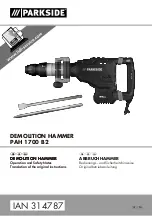
Instruction and safety sheet
www.cp.com
4/6
8
9
4
0
1
6
7
0
4
3
v
e
rs
io
n
5
Operation :
Vehicle(s) :
Equipment :
Brand :
Model and Type :
Free speed :
Max. torque :
Lubricated air :
Wheel s Mounting / taking off
Truck, Bus
Pneumatic nut runner
Chicago Pneumatic
CP7600xC R4P
100 rpm
900 Nm at 6.3 bar
Yes
Serial number :
Specific settings :
Setting pressure :
1:
N.m
2:
N.m
3:
N.m
4:
N.m
at
bar
Phases
Tasks to perform
Preparation
•
Wear the individual protection equipments defined in part "Information about the
operation".
•
Verify the good condition of the nut runner.
•
Verify and adjust when needed the reaction bar and/or the spring loaded cup.
•
Connect the air supply hose to the tool.
•
Verify that there is no leakage at the hose connection.
•
Verify and adjust when needed, the level of oil in the FRL.
•
Verify and adjust when needed, the pressure of supplied air by running the tool
under no load: Air pressure entering the tool = air pressure on tool certificate
•
Insert the socket to be used on the 1” square drive and lock it.
Tightening
operation
•
Position the nut runner as follows:
o
Engage the spring loaded cup on the torque reacting nut in accordance with the
curvature of the reaction bar.
o
Engage the socket on the nut to be tightened / loosened.
•
Adjust the rotation direction selector as needed (verify with the color of the arrow).
•
Adjust torque selector according to the specified torque to be applied to the nut
(refer to the manufacturer documentation for the torque value specifications).
•
Maintain the tool over the nuts by slightly pushing it towards the nuts.
•
Pull the trigger.
•
During the rundown phase, the socket turns quickly, whereas it turns slowly during
the final tightening.
•
Release the trigger when the air admission is shut off.
•
When the socket does not turn anymore, remove the nut runner and restart this
phase on next nut.
Important note about the tightening process!
Tightening nuts must be performed as recommended by the manufacturer of the vehicle (refer to the
manufacturer’s documentation). To limit relaxation phenomena, the process is split in 2 steps:
Snugging:
to seat all the nuts onto the rim (and the rim onto the hub)
Final tightening:
to tighten the nut up to the final torque when the tool shuts off
both performed in a specific sequence.
For instance for a 10-bolt wheel, the Tire Industry Association recommends the
following sequence:
Torque selector
Rotation direction selector
Socket
Spring loaded cup
Trigger
























